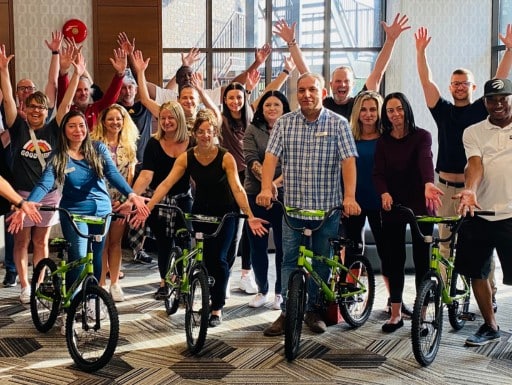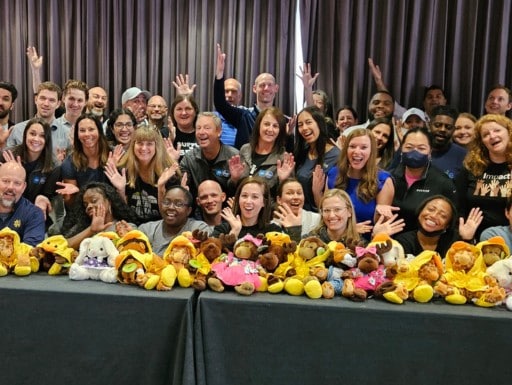5 Tips to Solving Team Disengagement with Team-Building Activities

However, sometimes, you may get results like this…
“We are doing more and more team-building activities, but our employee engagement survey results are getting worse. Why?” Companies want to build fantastic teams. And, since we only get the whole group together once a year, that is the perfect time to schedule team activities. Right?
Yes, but a little team development goes a long way. If you overdo it, you can actually cause your employees to disengage from team activities and events.
Here is the scenario that typically occurs.
First, our annual meetings are pretty boring, so we added a team-building event. That year, exit surveys go off the charts. The activity made the end of the meeting fun and interactive. The addition works so well that we add an additional game for the next meeting. Then another. Of course, now, the survey results go down slightly. Well, the last time survey results were lower, we added more team ice breakers.
In the survey comments, though, a small percentage of the participants put the following comments. “Love the fun team building activities! They are the best part of the meeting.”
So what the heck is causing the employee disengagement and negative survey numbers?
Employee Satisfaction Surveys Won’t Tell You the Full Story.

The second group likes team building as long as it isn’t cheesy. They like to build strong relationships with their coworkers but are more introverted than the Shooting Stars. We’ll call this group the “Warm Campfire” people. They appreciate the opportunity to network with coworkers in a fun way. (This group will give high satisfaction results but not leave a comment.)
Group three thinks of themselves as team leaders. So, they realize that team building is important. But they aren’t really excited about the activities. They think, “The rest of the group needs to be a better team — but not me.” (These are your “Type A” personalities.) So, if you organize a single fun team-building activity, they will give you high satisfaction scores. However, if you overdo it, they will feel like all the cheesy games are a waste of time that could be used more productively. We’ll call this group the “Captains.”
The final group is the folks who are more analytical. Just in general, they feel uncomfortable interacting with other coworkers. For this group, a single really good team activity is fun and helps them push their comfort zone. But, if you stack multiple activities, this group’s survey results will decrease exponentially. We’ll call this group the “Chess Masters.”
Some Employees May Be Extremely Engaged While Others Are Totally Disengaged Employees.

The thing to keep in mind, though, is that a little team building goes a long way. All four groups love a single really good team activity. However, once you stack a second activity, half the group will increase their satisfaction score while the other half will likely have decreased satisfaction. In this case, you could describe half your group as disengaged employees. The team morale of half the group will be low. However, the exit surveys won’t show this.
The only way to really build a great team is to get your entire group to WANT to be a great team. You can’t push a rope. So, team building events should be rare and exceptional if you want your employees to be engaged. The goal is to get your employees to want to attend each activity.
You want to make sure that any team activity that you schedule is an emotional experience. Be careful and avoid just stringing together a bunch of icebreakers or games. Every additional team activity that you add has a diminishing return on satisfaction. So, when you add activities to your meeting, you want to pick a winner that your group will love.
Here are a few tips that are a great way to solve team disengagement problems when you schedule team-building activities!
1) When Organizing Team-Building Activities, Less Is More.

Think of your meeting as being a nice holiday meal. The team activity would be the dessert at the end of the meal. You’re full already, but the dessert is so good you eat every bite. Now, you are stuffed. You have had a fantastic experience. Then, another dessert is put in front of you. The first bite might still be enjoyable. But, the more bites you take, the less enjoyable the second dessert is.
Here is the big problem, though. Most meeting organizers are from the “Shooting Star” group. They love to volunteer to organize the annual meetings. And, since they are really fun to hang around with, they typically do a great job of mixing in fun activities with the normal (boring) stuff. But they also fall into the trap of “if a little is good, then more is better, and too much is just enough!”
If You Overdo Team Activities, Your Group Will Hate It. (And You’ll never know.)

The organizers locked the banquet hall doors and had a “standing” breakfast in the hallway. They distributed “team bingo” cards to everyone. Some participants played. But others just tried to eat quietly while holding their plate.
When they finally opened the doors, the organizers required each table group to enter the room together. They called this the “parade of teams.” Some team members wore funny hats and glasses. Others danced to their tables. However, as the last few teams entered, I, as an independent third party, could tell they were really uncomfortable.
Next, the CEO came on stage. He attempted to do a little stand-up comedy. And it was pretty funny. (But also a little awkward.) Next was an annual award ceremony. They recognized over 100 of the 500 participants. (It got a little long.)
Then, we started the Build-A-Bike ® activity. By the way, they had fun. And we got great reviews for the activity. But I know for a fact that many of the participants hated the whole morning. None of them ever told anybody, though. They would have been considered the “outsiders” for doing so. So, they just kept quiet.
They had a fantastic cake in the center of the table. But they put a donut in front of everyone. Then a cheesecake. Then a pie. And they didn’t realize some people in the room were diabetic.
Remember, in team building, less is more!
2) Schedule Fun Team Events at the Crescendo of the Meeting.

Meeting organizers will often put general sessions where executives speak in the morning. Then, in the afternoon, they often insert breakout sessions or something more interactive or fun than the morning content. After 4:00 PM, though, any activities should be almost pure entertainment. (Or cut them from the agenda entirely. Remember, less is more.)
Over the years, we have found that the optimal time for a high-energy team activity is between 3:00 PM and 5:00 PM as a meeting close. An optimal meeting day with high satisfaction and engagement would look like this.
- 9:00 – 10:15 AM General Session.
- 10:30 AM – 11:45 AM General Session Continued.
- 11:45 – 1:00 PM Lunch.
- 1:00 PM – 3:00 PM Breakout Sessions or Some Knowledge-Based Content that Is More Interactive (Fun.)
- 3:15 PM – 4:30 PM Team Building Activity.
Be careful to not think, “We only get together once a year. We need to maximize our time together.” This way of thinking will create more disengagement than any other mistake.
Should We Provide Entertainment in the Evening?
For multiple-day events, the temptation is to add evening activities for the group as well. In most cases, your group will like the meeting more if the evenings are open and more flexible. If you do schedule something, though, it needs to be pure entertainment. (Don’t force your employees to do a team-building activity after hours.) Also, your event will be more cost-effective if you make it optional.
For instance, one of my clients had their annual meeting in Las Vegas. They ended the day by having the whole group go to a Las Vegas show. Yes, it was pure entertainment. However, they had participants coming in from all over the world for the meeting. Forcing people from different time zones to attend a meeting from 8:30 AM to 5:00 PM and ending with a 9:00 PM show made for a very long day.
They would have saved a lot of money and increased satisfaction levels by making the show optional.
3) To Solve Team Disengagement, Stay Away from Anything Cheesy.

Remember that what will be fun for the Shooting Stars will likely seem cheesy or corny to the Chess Masters. The goal is to pick a team activity that all four groups will enjoy.
For instance, having a team happy hour with snacks is a good choice. Everyone likes eating and drinking. And even if folks don’t drink alcohol, they will still enjoy chatting with coworkers.
But if you add a karaoke activity to it, that is a bad choice. Some people will likely enjoy it. Others will feel pressure to get up and sing even if they aren’t great singers. It has the potential to make some in the group feel uncomfortable.
However, if after everyone has a few drinks, you have a piano player come in for a sing-a-long, you’ll get much better results. No single person is put on the spot. The whole group is singing Sweet Caroline, so everyone feels like they are a part of the same team.
Is My Team Activity Cheesy (Corny)?
The easiest way to determine if an activity is a good fit is to think of each of the four groups independently. Let’s use the activities above…
| Activity: | Shooting Stars | Warm Campfires | Captains | Chess Masters |
| Eating and Drinking Together: | ✓ | ✓ | ✓ | ✓ |
| Networking: | ✓ | X | X | X |
| Networking While Eating and Drinking Together: | ✓ | ✓ | ✓ | ✓ |
| Karaoke: | ✓ | X | ✓ | X |
| Piano Sing-a-Long (after Drinking): | ✓ | ✓ | ✓ | ✓ |
Basically, just put yourself into the shoes of someone from each group. If you just consider how you see the activity, you may accidentally put someone with a different personality into an uncomfortable situation.
4) Your Team Will Grow When They Are “Doing,” Not “Hearing.”

A good team-building activity will get the entire team interacting with each other almost immediately. The longer it takes for the speaker to give instructions, the more disengaged the group will become. For instance, organizers will often want to start the activity by thanking all of the participants who helped set up the event. Sometimes, the activity will have a Corporate Social Responsibility aspect or a Diversity and Inclusion aspect. And the organizer will start the activity with five to ten minutes of introduction.
These preambles are often disconnected (and boring.) So, adding long-winded introductions like this will create disengaged employees in your audience.
Another big mistake is to give everyone in the room a chance to introduce themselves to the group. This sounds like a way to get the whole room to participate. However, it has the opposite effect. For instance, let’s say there are just 20 people in the room, and we give each person 60 seconds to introduce themselves. That is one minute of action and 19 minutes of sedate listening.
So, to avoid disengagement in a team-building activity, get the audience doing something — not listening to someone.
Get Your Team to Interact Right Away to Avoid Disengagement in Training.
Years ago, the leader of the meeting I was in asked everyone to think of an animal that represented them. Then, she asked everyone to stand and tell their name and the animal. There were 40 people in the room, so the whole intro took over 30 minutes. It was also really boring, with a few chuckles along the way. It was also really uncomfortable. (along with cheesy and corny — see tip #3 above.)
The leader of the group meant well. She just wanted to do something different and fun. But the activity bombed.
In contrast, often, when we start meetings, we teach the group how to get a coworker to open up by asking questions. We teach the activity very quickly. Then, within minutes, we have them practice with a random partner. After a few minutes of everyone in the room talking to each other and practicing the skill, we put the group into small groups. Then, we have each person introduce their partner to the new group.
Option one has one minute of action and 35 minutes of sedate listening. But this option has everyone alternating between interacting and listening every minute or so. The energy in the room will be higher. And the satisfaction level of the group will be much higher as well.
5) Add a Charity Donation to the End of the Activity for an Emotional Appeal.

Charity team-building activities add an emotional appeal to the meeting. For instance, you can build bicycles for kids in your community. You can make the activity fun and interactive by having the group earn their bike pieces. Then, as each group conquers the last challenge to earn the last piece, have kids from a local children’s charity rush into the room. The process takes problem-solving skills and gets the participants to focus on a common goal.
The emotion in the room will explode.
The big thing to understand about this part of the team activity is that this is NOT a service project. Don’t get the two confused. An activity with a charitable contribution is totally different from a service project. A service project is just manual labor. This is typically very interactive but not very fun.
Think about the last time you left Ikea with a box. You probably weren’t thinking, “Man, I can’t wait to put this thing together.” If you confuse a team activity with a service project, you’ll most likely create an activity with more employee disengagement.
*** Bonus Tip to Solve Team Disengagement During Your Annual Meetings or Conventions. ***
Business leaders often schedule these annual meetings at fantastic resorts. Then, they violate tip #1 and overschedule each day. Also, remember how earlier I mentioned that the surveys won’t tell you everything? As a result of overscheduling, these organizers will now see comments on the surveys like, “Can we do something outside next year?”
The obvious conclusion would be to schedule outdoor activities next year. Right?
Actually, if you make this mistake, you will guarantee low employee engagement for the outdoor activity. If you make your entire company go outside in the hot sun to play a game together, you just have a lot of uncomfortable employees. First, did I mention the hot sun? Second, all the group really wanted to do was take a break so they could hang out by the pool. Now, you have them playing games by the pool without being able to enjoy the pool. The good news, though, is there is an easy fix to this challenge. Give your employees a break so they can go to the pool or beach or explore the resort.
The only exception to this tip, by the way, is if you organize scavenger hunts or treasure hunts for the group. These outdoor activities can be an excellent way to build team work and explore the area.
Solving Team Disengagement in Team Building Activities Takes Great Planning.
You won’t just accidentally build a great team. It takes planning and consistent effort. But you don’t have to do everything yourself!
You have a ton of stuff to do in your day-to-day operations. And organizing a fantastic team-building activity is easier if you outsource the process to an expert. Just click the link for details.
